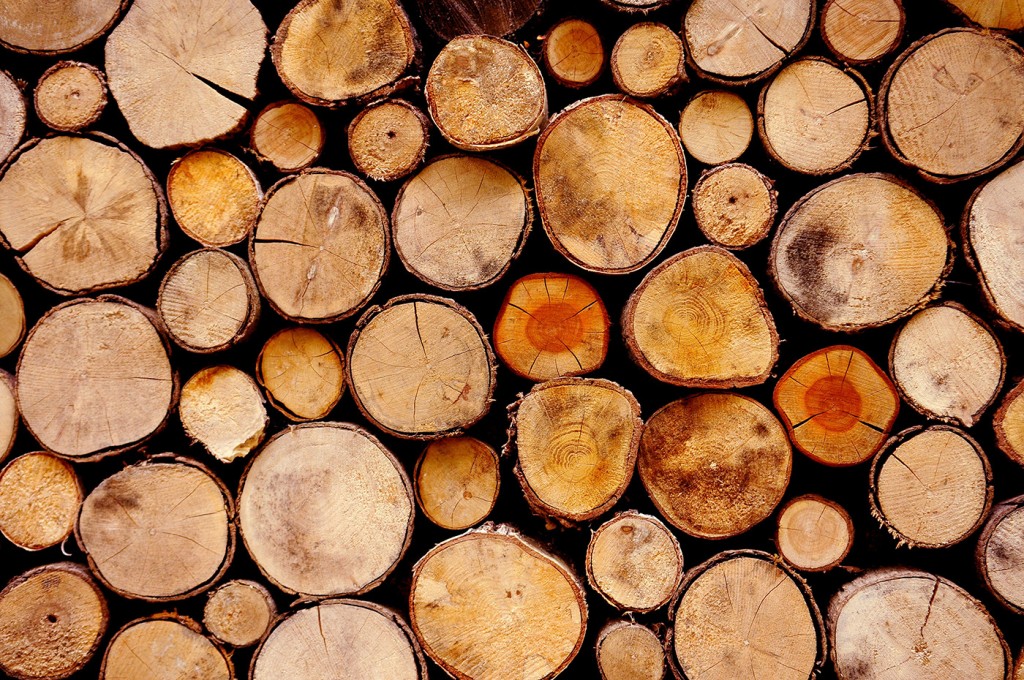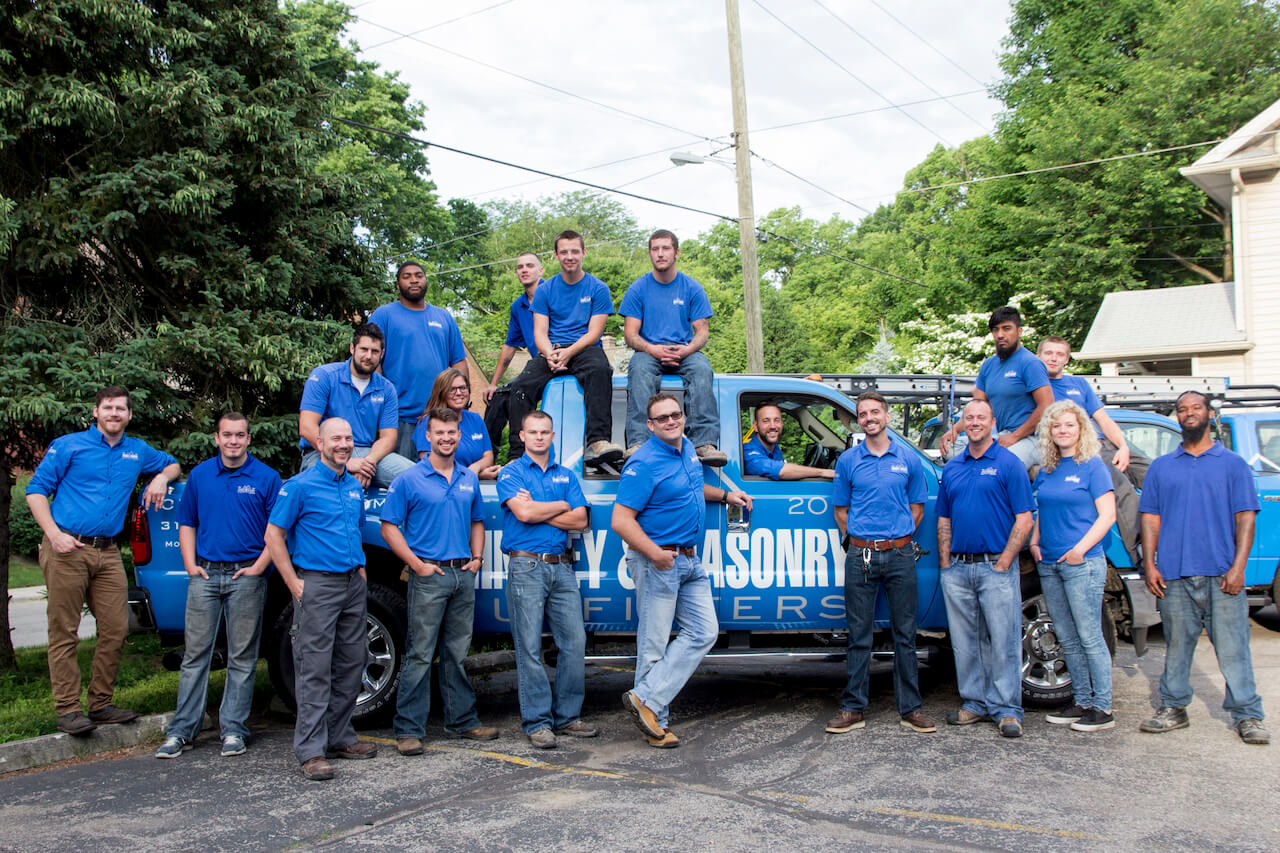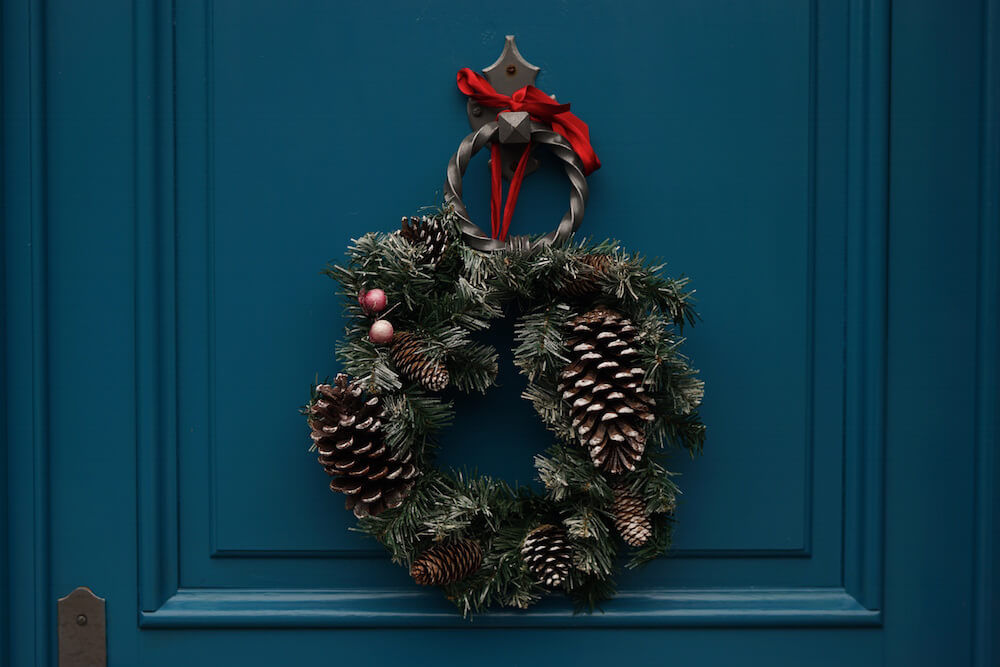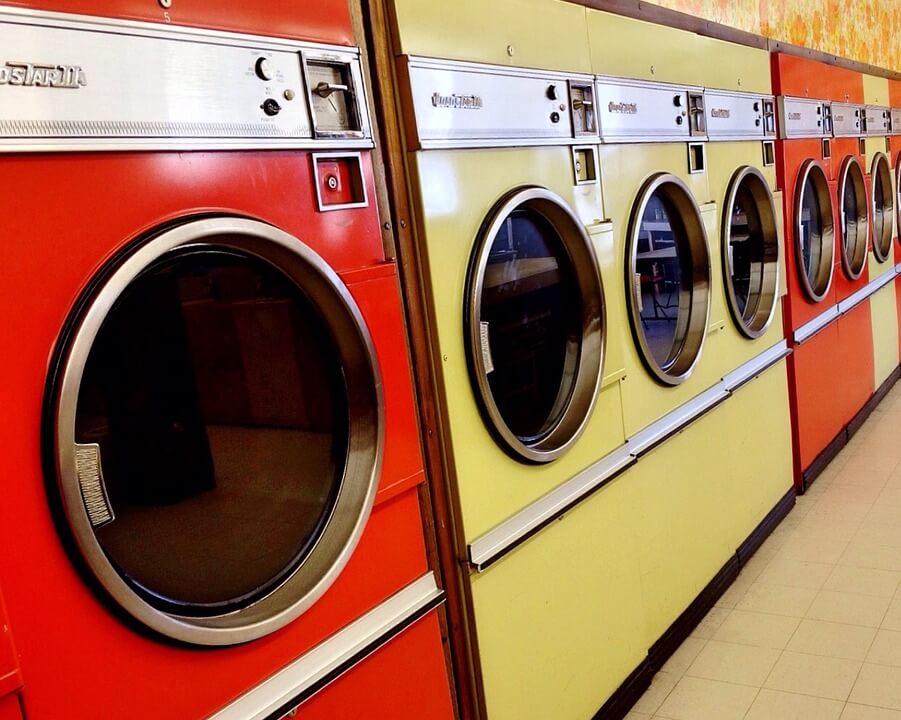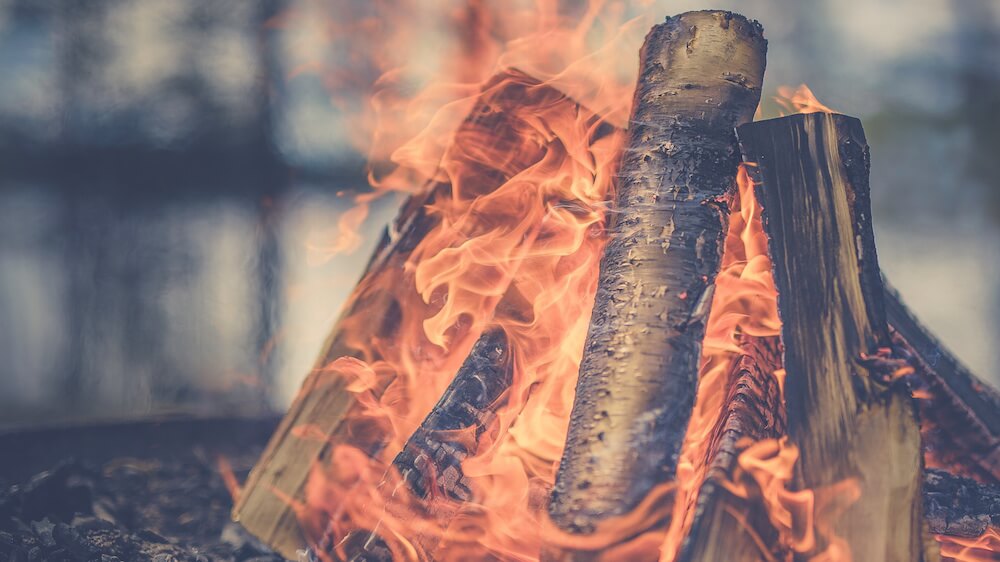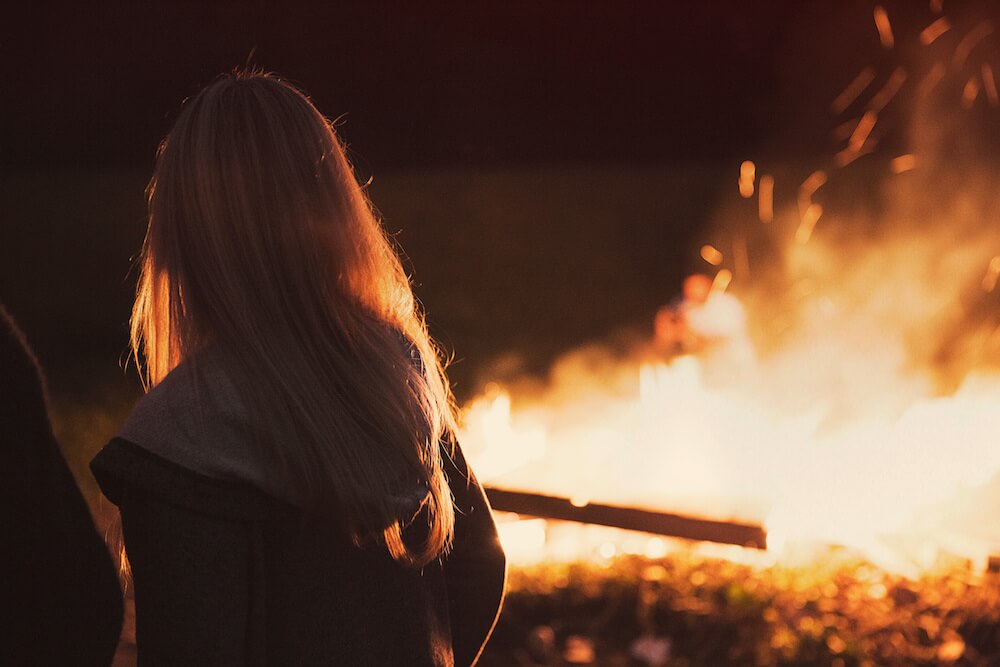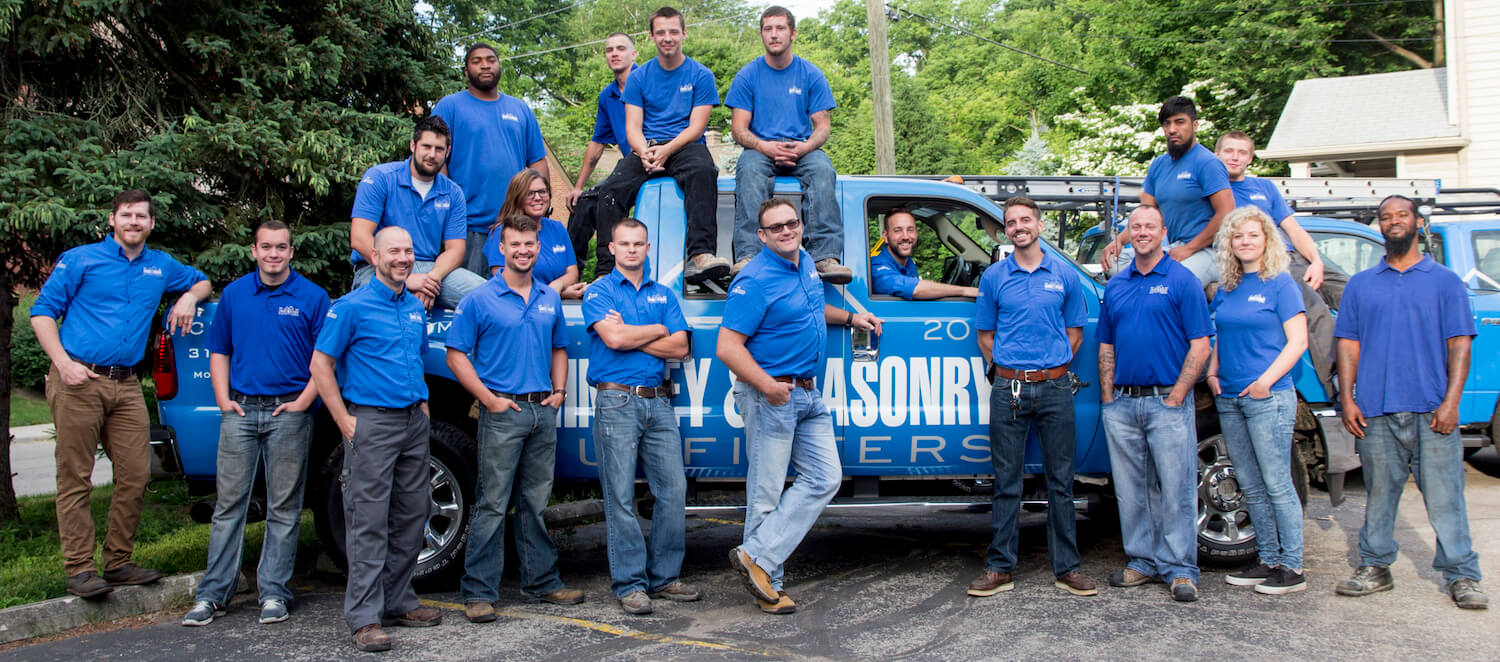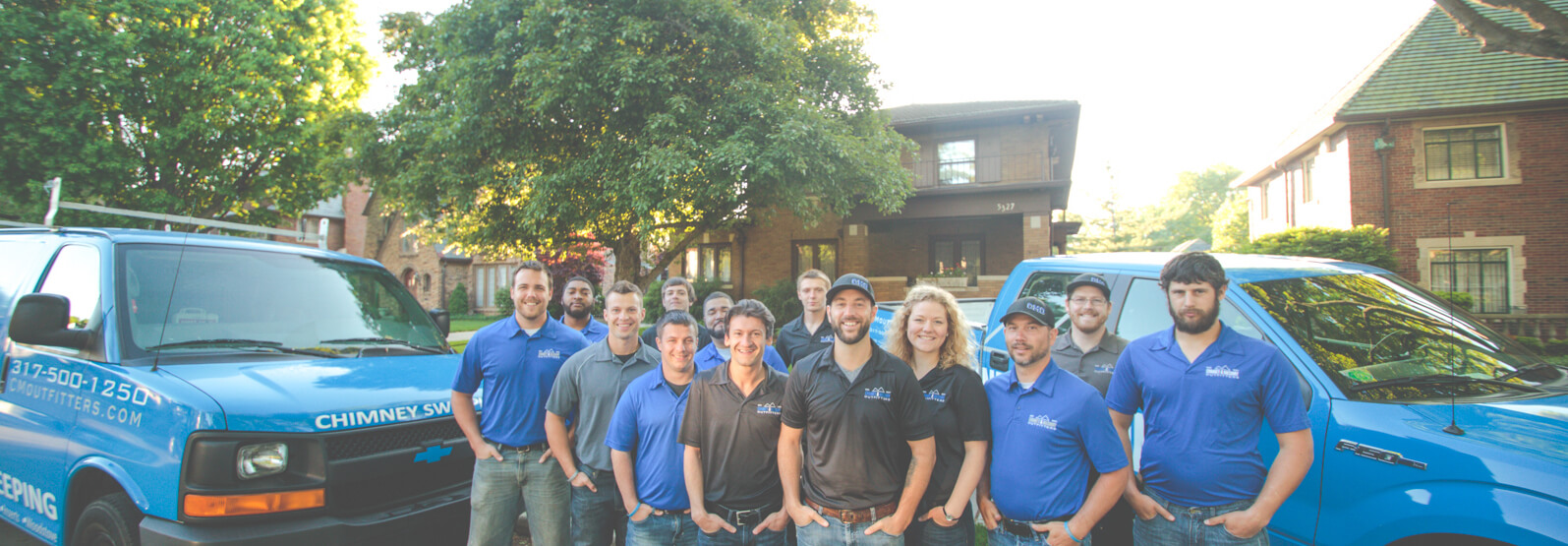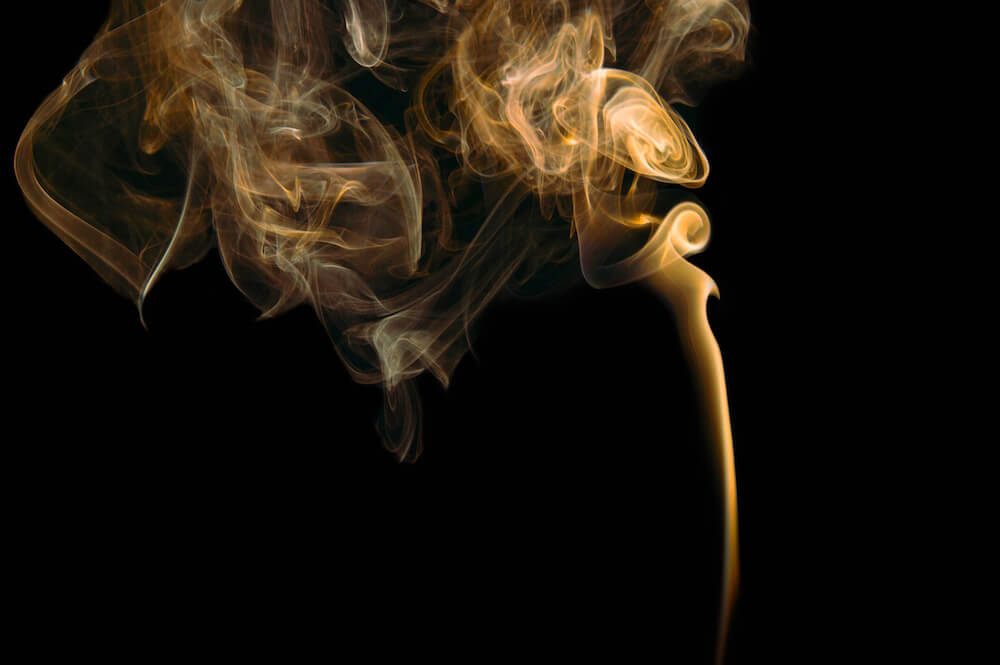It's Burn Season - What Wood Should I Use
The wood you choose as a homeowner will affect the efficiency of your fires, and the functionality of your fireplace's chimney. Firewood advised for use in any wood-burning appliance (fireplace, stove, etc.), is well-seasoned wood, as opposed to greener, more freshly cut wood. Due to the amount of sap or water you may experience more smoke, more rapid creosote buildup, and potential chimney/flue fires.
While avoiding having any water-content in firewood is impossible, the percentage of water-content makes a difference. Seasoned wood is wood that has been stored for up to 6 months or more, allowing the water to evaporate (which means it needs to be covered - more on that later).
Why less water? The energy of the combustion, or the fire, is best spent burning the wood, not drying it out, while attempting to burn it, not to mention all of the sap and other moisture released, which will stick to the flue system (creosote alert). The more water in the wood, the cooler and less efficient the burn will be, and you really have wasted a chunk-of-change in the process. Those waterways in the wood need to be dried out a bit before you can make good use of the wood, so step one to good firewood is well seasoned firewood.
The CSIA gives some helpful tips to determining the readiness of the wood you might be looking to pick-up:
"Well seasoned firewood generally has darkened ends with cracks or splits visible, is relatively lightweight, and makes a clear "clunk" when two pieces are beat together. Green wood on the other hand is very heavy, the ends look fresher, and it tends to make a dull "thud" when struck" (CSIA - Firewood Testing).
The best route may be to simply purchase the wood well-in-advance of when you intend to burn in the fireplace, stove, or other wood-burning appliance (say the Spring, as opposed to the Fall). Get it covered and keep it off of the ground, let the sun and wind do the work of dehumidifying the wood for your intended use. The idea is to keep it covered, but to keep moisture out, so a wood-shed, or even a tarp. You may want (need) to remove the tarp on sunny-days to allow minimal moisture to be present (remember you are drying the wood out).
Let's say you decide to burn the green wood anyways - have the chimney checked pretty shortly after, as it is fairly likely you will have built up creosote quickly from the lack of efficiency and heat of the burn.
Okay, so you have the whole "well-seasoned wood" concept down, but what wood should be used?
The dryness of the wood is really the most critical piece here - treated woods for construction (decks, landscaping, or other alike uses), are not ideal. Inhaling wood-treatments is not going to benefit the health of anyone, so stay away from these woods. Additionally, let's avoid painted woods while we are at it - we do not think this needs much more explaining (is the paint on that wood lead paint, let alone any other paint? Yea, not ideal).
The density of the wood also plays a role in the longevity of your burn, so the lighter wood makes for great starters and shorter burns, while the denser wood is more ideal for the cooler weather where less trips to the wood-pile is a more preferred method to fire-enjoyment.
This should get you headed in the right direction when it comes to the wood you decide to burn in the fireplace, stove, or other wood-burning appliance through the season. Please adhere to the industry recommendation (both the CSIA, and the National Fire Protection Association) of having an annual chimney sweep and inspection performed prior to use (more if wood is burned fairly often).
If you are looking for a place to purchase seasoned wood, one of our Outfitters would suggest:
Bark Farmers
2460 N Arlington Ave, Indianapolis, IN 46218
(317) 545-2275
Brick + Ember Outfitters believes in the value of educating its homeowners, allowing them to make empowered decisions toward the safety and functionality of their chimneys and ultimately their homes. Please do not hesitate to reach out to Brick + Ember Outfitters with any questions about your chimney or masonry needs!
Meet Chris!
Meet Chris Keen: B+E's Outfitter of the Month for December!
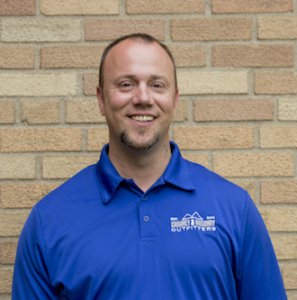
A Winter-Market isn't Necessarily a Waste
HGTV's, Scott McGillivary notes that selling a home in the Fall and Winter seasons is a completely different ball-game. While not at all a selling-impossibility, there are some things as an agent to advise your sellers, which could increase the potential for a winter home-sale-closure.
Here are a few tips for the winter market shared from a real-estate article by the US-News from back in October of 2016:
Photos from the Spring
Photos from the Spring will not only allow potentially interested buyers to know what the home looks like in other seasons, but also that the home does look different in other seasons!
Curb Appeal Still Matters
Arguably, curb appeal always matters; tending to the yard is valuable work for the sake of the sale. Even in the cooler/winter months keeping the yard clear of leaves and sticks keeps a synergy of orderliness and seriousness to the sale.
Minimize Indoor Maintenance Mishaps
Ensuring the heating appliances are up-to-date on all maintenance prior to showings and any open-houses is a major necessity when marketing a house in the cooler months.
The More Light, The Better
There is less daylight during this time of the year and trying to sell a dark house is not an ideal marketing strategy for an eager seller. This could mean additional lighting in the home, or landscape lighting for the exterior of the home, or both. Ensuring the lights in the home are all working is also going to be a great plan for making showings a smooth event.
There Will Be Less Showings
Yes, there probably will not be as many showings as there may be in the Spring or Summer months, but buyers may be more motivated - are they always? No, but the likelihood that they may be more serious could be higher in the cooler months, given that the market may have less options available for sale.
Marketing May Need a Further Reach
McGillivary also stated that companies more often re-locate employees in the Fall - he encourages readers to reach out to relocation specialists or major employers in the area. It is much less likely that the Indianapolis market is the place for a winter-get-away. It certainly is not an impossibility.
Flexibility Helps
Closing could take longer with the busyness of the winter bustle. It does slow down after the New Year, but once a closing begins, rushing the buyer through it may not be an ideal strategy to the closure of a sale.
Don't Expect A Price Explosion
Unless you are feeling desperate on behalf of your seller, low-ball offers are really not worth taking if all of the effort of keeping the house on the market is to hold the value of the home. While the offers may be below asking-price, low-ball offers are not said to be worth taking according to Boyenga, who leads a team of Real Estate agents in the San Francisco market.
...
Too Much Seasonal Decor Can be a Turnoff
Everyone loves the Fall and Winter months for the opportunity to decorate and make our homes an extension of their excitement for celebrating the holidays. Overdoing it may be a detriment to the attractiveness and marketability of the home - the pumpkins? Yes. The spider-webs and Halloween streamers in the trees? No. Christmas tree in the living room window? Yes. Santa and the reindeer on the roof? No.
Highlight Seasonal Pulses
Stokes, a real estate agent in the DC area indicates that lighting a fireplace during a showing can add to the sense of cozy and inviting. Here is where we would like to chime in as your Brick + Ember Outfitters - ensuring your homeowners, who intend to sell, have addressed the cozy fireplace prior to the showings and open-houses may be advantageous to you as the agent. Capitalize on the fireplace and use it for the selling-point it can really be for the home. Moreover, marketing the safety and functionality of that chimney and fireplace increases the selling equity, and peace of mind of the potential buyers. You are not going to have a selling point with a home that back-drafts and has a smokey smell coming from that fireplace/chimney.
There IS a Point Where You May Want to Advise Holding Off
After the New Year may be the time to put the home back on the market. While it may not be idea, waiting a bit for the busied Holiday season may be the best option, and you will save time on the recorded time on the market, which always raises odd questions.
While Brick + Ember Outfitters may be most specific to the chimney or masonry work of the home you are looking to sell, we certainly may be able assist in the marketability and appeal of that home. The winter market may not necessarily be a waste, but marketing mishaps may mean more time on the market.
At Brick + Ember Outfitters, we are inspired by the value of increasing equity, restoring beauty and growing peace of mind for our homeowners. Selling a home in the Fall or Winter months? Give us a call and ensure the safety and functionality of the chimney and fireplace, and then use it for those open houses, and showings, and market the readiness for those potential buyers to enjoy this feature of their home-to-be!
This Time It's Not The Chimney - One Household Appliance You Might Forget Needs A Once-Over Each Year...
The Dryer Vent? Yes - did you know that "failure to clean" is the leading factor contributing to clothes dryer fires in residential buildings? When did your dryer(s) last receive maintenance? Also! You know how there is always that one dryer that runs a little warm, and takes a little less time than the others in the apartment building - it is super convenient but also seems to make your clothes smell a little 'hot?' Not ideal.
And for our homeowners, get back here, this applies to you too - here are 7 Facts for you from the CSIA about Clothes Dryer Exhaust Safety:
- 1. According to manufacturer’s specifications and local codes, dryer ducts must be a minimum 4” in diameter and at least as large as the dryer outlet.
- Unless otherwise specified by your dryer’s manufacturer or local code, the developed length of your dryer’s exhaust duct should not exceed 25 feet. (When determining developed length, each 90º turn adds 5 feet to the actual length.)
- Dryer vents shall be independent of all other systems and terminate outdoors, not into a chimney, crawl space or attic.
- Your outside dryer exhaust vent’s termination hood should be equipped with a back draft damper to ensure that the exhaust doesn’t come back in your home.
- Metal transition ducts should be used between the dryer and the exhaust duct.
- Flexible transition ducts should never be used in an attic, a crawl space, or inside a wall.
- The CSIA Certified Dryer Exhaust Technician credential is the only nationally-recognized credential of its kind."
One more for those who are huge fans of your clothes [we assume most people apply here] - if you have neglected the dyer, running at higher than standard or intended temperatures, leading to a decreased life, and increased wear of your clothing - that is, if they don't inadvertently ignite due to an overheated element or safety mechanism. Additionally, do you ever keep going back to the dryer, once it has finished and find that your clothes do not seem to be dry, for the third time? The dryer vent may not be breathing so well.
At Brick + Ember Outfitters, having certified sweeps and technicians who have completed the training by the Chimney Safety Institute of America to ensure their knowledge of the venting systems of your home is critical to how we strive to grow your peace of mind.
Have questions about the hook-up of your dryer-vent? Just need it cleaned for the sake of safety and efficiency? We can do all of those things - give us a call!
Chimney Sweeping Logs VS. A Chimney Sweep
It is an "And" rather than a Vs., folks - Chimney Sweeping Logs AND a Chimney Sweep.
Chimney Sweeping Logs are accepted by the CSIA, as stated on their website - but, only when used in accordance with the manufacturer's direction (CSIA - CSL).
The purpose of the CSL is to reduce the amount of creosote within the fireplace flue system and ideally improve the efficiency of the heating a home, when utilizing the fireplace. While the packaging of the CSL will include the stamp of approval by the CSIA, you will also find the package states, "Regular chimney inspections are always recommended." The stamp of approval from the CSIA, and the message that follows is an extension of the message which communicates the importance of the annual chimney sweep - knowledge is responsibility folks!
Furthermore, as anyone may conclude, and what seems quite obvious, is that those chimney sweep logs serve a great purpose, but are not a chimney sweep who will be informing you of the condition, functionality, and ultimately, the safety of your fireplace-chimney. The CSL does not replace the sweep, but is best utilized in addition to the chimney sweep.
Brick + Ember Outfitters ensures that their Chimney Sweeps are certified by the Chimney Safety Institute of America, so that you are being educated, equipped, and empowered to make the very best decisions regarding your chimney and the safety of those in your homes.
We'll keep this one short and sweet, so in final - the CSL are a great additive to assist in the reduction of creosote and fireplace efficiency, but "these three elements are necessary to ensure a safe and properly functioning chimney:
- A complete chimney inspection by a qualified professional [at least once annually]
- Performance of necessary chimney repairs by a qualified professional
- The mechanical sweeping of the chimney of the chimney and the removal of creosote and other potentially hazardous material by a professional chimney sweep" (CSIA - Necessary Elements to Proper Chimney Function)
Brick + Ember Outfitters is committed to educating, equipping, and therefore empowering its homeowners toward a growing peace of mind, when it comes to the chimney and masonry needs of our cities. Any questions or concerns related to your chimney or masonry work, please do not hesitate to reach out!
What Is a Flue (Chimney) Fire - Should I be Concerned?
A Flue-Fire, also known as a Chimney-Fire is caused by the reigniting of the hazardous and extremely flammable creosote residues left in the flue due to burning of fires in the fire-box. Here is the thing, there is really no way around creosote - it is a byproduct of wood-burning and is due to the gases during the combustion (wood-burning) process, not being burned up completely - hot air rises, yes, but as those gases head up the flue, they are cooling down, and sticking to the sides of the flue system - ergo, creosote.
Creosote is combustible, so, once you have burned for a while, and not had the chimney swept or inspected, imagine what sort of hazardous material situation you have left for your chimney. When a chimney/flue fire occurs, the temperatures of these scorches can reach up to 2000°F. Temperatures this hot are no match for your clay flue tiles, the mortar between them, or the liners that are designed to send the heat out away from your home - instead, you may very well experience a chimney/flue fire, which may be recognized by loud popping noises, dense smoke billowing out of the top of the chimney and in some instances, flames which rise or are visible out from the top of the chimney - not ideal. Those popping noises are not the noises you hear coming from the logs in the fire-box, that is simply the water or sap bubbles in the wood being heated up, expanding and cracking the wood - the popping you should be concerned about at this point is happening above your head - up in the flue.
Are your chimney/flue fires always going to reveal themselves with the above indicators? No. Do not count on it - if there is not enough air to make for flames shooting out of the flue, or loud popping noises, the temperatures of a flue-fire are not reduced. A chimney sweep and inspection is the best way to reduce and omit this from being an experience as a homeowner, with the potential of watching your house burn down due to failed stewardship of owning a home with a chimney.
There are indications that a chimney/flue fire has occurred in your chimney and we will list a few, but again, know that we offer a camera/video inspection with our sweeps, so no only will a sweep by a certified sweep professional be performed, but you will have some peace of mind knowing the condition of your chimney's flue system before burning.
The folks over at the Chimney Safety Institute have listed a few signs that a certified professional sweep will look for that may indicate a chimney flue-fire has occurred:
- “Puffy” or “honey combed” creosote
- Warped metal of the damper, metal smoke chamber connector pipe or factory-built metal chimney
- Cracked or collapsed flue tiles, or tiles with large chunks missing
- Discolored and/or distorted rain cap
- Heat-damaged TV antenna attached to the chimney
- Creosote flakes and pieces found on the roof or ground
- Roofing material damaged from hot creosote
- Cracks in exterior masonry
- Evidence of smoke escaping through mortar joints of masonry or tile liners
If you have recently purchased a home and have not had the chimney inspected prior to use, we would suggest it before you sit down to enjoy the fires. Otherwise, homeowners, it is recommended by the chimney sweep industry to have a chimney clean, sweep, and inspection at least once annually, if not more (depending on the amount of burning done).
Do All Sweeps Accomplish the Same Thing
Your Certified Chimney Sweep can check the fireplace flue, and the furnace flue. That is a two for one, and then you are done - do not make this more complicated than it really is - it is not.
Are all chimney sweeps alike? Or do all chimney sweeps accomplish the same thing?
Great question - but no, they differ depending on the needs of your chimney and venting appliances.
There are three 'levels' to chimney sweeps:
A Level 1 Inspection is an assessment of the immediately accessible components of the chimney - inside and out. Your Chimney Sweep will address the chimney for structural stability and the connecting components between the furnace to its flue, and the fireplace to its flue. In addition to ensuring the soundness of the accessible components of the chimney, the Chimney Sweep should also be looking to address any creosote, blockages, or any other hazardous concerns prior to advising any burn to take place.
A Level 2 Inspection is required and necessary when any changes are made to the chimney system – we mean any changes - if you are not sure what may constitute as ‘any changes,’ give us a ring. As one may assume, the Level 2 Inspection is a more extensive inspection than that of a Level 1 Inspection – which includes a camera or video scan in addition to the visual inspection performed by the Chimney Sweep. A camera inspection allows your Chimney Sweep to survey and accurately address the flue-system and any related concerns which homeowner (you) would need to know about prior to burning or continuing use.
A Level 3 Inspection, without a doubt, includes the execution of both a Level 1 & 2 inspection, but also requires the removal of components or obstructions which would inhibit the Chimney Sweep from accessing a concerning or problematic area of the chimney. Removal may include, but is not limited to, a rain-cap, an interior wall, other drywall or even dampers. The Level 3 inspection would be performed because your certified Chimney Sweep has reason to believe that there is proper cause for concern.
At Brick + Ember Outfitters, all of our Chimney Sweeps are certified by the Chimney Safety Institute of America, and are readily able to perform any level of sweep necessary, per the needs of your chimney and venting systems, or order to ensure the safety and functionality of those venting systems.
We believe that educating our homeowners, is empowering our homeowners - equipping them to make informed decisions about who they request for their chimney and masonry needs. Grow some peace of mind, and have your chimney/venting systems checked for safety and functionality.
Meet Paul!
Meet Paul Johnson: B+E's Outfitter of the Month for November

Be More Than a Pro, Be Proficient – Do Real Estate Agents Know Best?
Fall is settling in - the trees blare with colors of warm fires and the temperatures are exactly what we can expect of Indiana's transition seasons - complete inconsistency. Yards accumulate with leaves and leaves, and leaves.
As an agent you are looking to make that house the most marketable piece of land you possibly can – things slowdown in the Fall, we know, and here is a few tips that can help!
We're headed into burn season - and if that house has a fireplace - capitalize on that selling point Real Estate people!
Your potential buyers are going to notice it. The better it looks, and the more you know about the condition and functionality the more trust and marketability you will have in the sale of the home - and, if you know it needs work, you could potentially save your buyers a pretty-penny to get the necessary repairs done by move-in date.
We know it is 2016, but in a 2007 National Association of Realtors, "Profile of Buyer's Home Feature Preferences" report, the fireplace was "very important" in the decision making process when it came to house-hunting. While the expectation and use of the fireplace has changed drastically over the years, the older homes (Meridian-Kessler, Butler-Tarkington, Broad Ripple) generally have the remnants of a masonry fireplace and often require a bit of "TLC" to get the back to safe and functional.
The types of fireplaces in homes could differ and being proficient in the needs of each of these fireplace/chimneys is going to put you in a position of power for negotiating and educating your buyers.
A few terms related to the fireplace in general are the hearth, firebox, facing, mantle, and the chimney:
The Hearth refers to the material that lies in front of the fire-box (see below for description of fire-box) - this ought to be fireproof materials (stone, masonry, or an alike material), and have a depth of 12 - 18 inches - not meeting code could be a serious issue to inform your buyers to address prior to singing their lives away.
The Facing refers to the material on the wall around the opening of the fire-box (see below for description of the fire-box). This ought to be fabricated or designed with fireproof materials (stone, masonry, concrete, metal). There are codes on this area too, so be weary anything that looks odd, or unsafe..
The Mantle is more of an extension or accent of the facing of the fireplace. The mantle can surround the 'facing' or simply be an accent shelf above the opening of the fireplace. Ideally the mantle is going to reflect the design of the room or home, and can easily be changed to accomplish - do not let your buyer lose sight of a vision for the home if the mantle isn't right - it can be a wonderful winter project (HGTV can take care of them here).
The Firebox is the "box-shaped" area in which the fire or combustion actually takes place (where you put the logs/where the gas-logs are located). This ought to be lined with fire-brick (if masonry) or refractory panels (if gas, or a factory-built unit). If there are cracks or missing mortar between the bricks in the firebox, point that out to the selling-agent, but first call us - we can give you an estimate to report back to the selling-agent.
The Chimney refers to the actual exhausting system, which is located above the firebox (generally behind a wall). The damper is the means to getting into the chimney (if the damper is at the bottom and is not a top-mount damper. Hint: this would be a good thing to know as the agent). The chimney is designed to regulate the airflow.
A great opportunity to serve those buyers would be to bring a chimney sweep in to have the chimney swept and inspected prior to even having them there so you have the scoop on the chimney and any tips they will need, in order to be ready to proceed with you through the final-sale of the home.
It would be a total flop if it came to the chimney and the sale was lost because you did not do your homework. Have the chimney cleaned and inspected and leave the buyers with a little peace of mind (whether for better or worse), right? What a smear on your name if the buyer gets a faulty chimney...do not be that agent.
Brick + Ember Outfitters is all for making you an added-value agent, and a sweep and camera inspection is an extremely practical way to serve your buyers. Grow some peace of mind, while growing your buyer-reputation - get the chimney swept and inspected.
We are on MIBOR, Talk to Tucker - check us out, and give us a call!
Chimney Sweeping, Smoke Alarms, and the Educated Homeowner
A chimney sweep is recommended at least once annually by the National Fire Protection Agency - from their mouths to your ears (or eyes, in this case) - Standard 211: "chimneys, fireplace, and vents shall be inspected at least once a year for soundness, freedom from deposits, and correct clearances. Cleaning, maintenance, and repairs shall be done if necessary."
But let us assume that this is not an industry regulation that you find necessary for the safety and functionality of your home - fine. The chimney has never been cleaned before, why start now, right?
The National Fire Protection agency recently wrote an article about why they continue to push the importance of smoke-alarm awareness. In short, the state fire marshal of Massachusetts held a press conference due to an increased amount of house fires - many of the homes reported in these fires did not have working smoke-alarms. Here's another statistic from the article that may be mildly alarming (pun intended) - "Almost 40 percent of the fire deaths that occur in the U.S. are in homes with no smoke alarms" (NFPA-Journal). The number one cause of house fires is cooking equipment, second to this is heating equipment - that would include the chimney, or furnace - potentially both of those have flues which are exhausted by your chimney (note: we are aware that newer furnaces can and do often exhaust out the side of the basement wall anymore).
Okay, shop around and do your thing when it comes to getting the chimney swept - find the cheapest deal, and get the cheapest sweep ever, but ask if he or she is certified by the CSIA, and did you get a camera inspection done, because how is he going to tell what exactly is happening up in the flue system - are there holes, is there missing mortar between flue-tile joints, and what about the flue liner? Is that so totally free of debris, like the highly flammable creosote that builds up in the chimney flue system due to burning? What about a chimney fire - is there any indication that one of those has occurred in the flue system, because there could be serious damage done to the liner or flue tiles.
If you are not sure about any of these answers, and neither is your potentially non-certified chimney sweep, you will definitely need to ensure the longevity and active-alertness of the smoke detectors in your home. No sweep, no peace of mind - I guess you can leave it to your smoke-detector/alarm. In our minds they are sort of hand-in-hand.
How many years is a smoke-detector/alarm good for? Right - 10 years.
Take the smoke detector/alarm off of the ceiling or wall, and ensure you are not surpassing that expiration date. There are often instructions on chirps, if the smoke-detector/alarm has started chirping. And in case there was ever any confusion about the chirping - the smoke-detector/alarm was not designed with a chirp to be ignored. For the millennials, imagine the chirp is like your phone pinging you with a text message - like, "HEY! I'M GONNA NEED A NEW BATTERY, LIKE NOW."
Getting your venting systems swept is intended to give you a peace of mind - the smoke alarm is the peace of mind's teammate. Decreasing the potential hazards of destroying your home is always advised - we are giving you two ways to increase the peace of mind of home ownership - for free.
Get the chimney swept by a certified chimney sweep - Brick + Ember Outfitters - and check your smoke-detectors/alarms (or install them if you have not already).
Referenced articles: NFPA - STATISTICS

